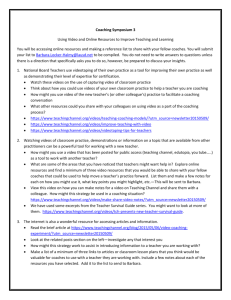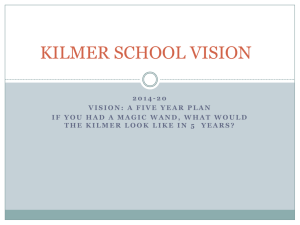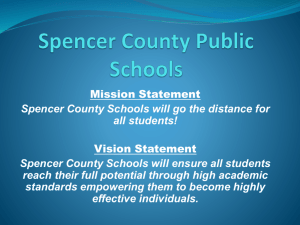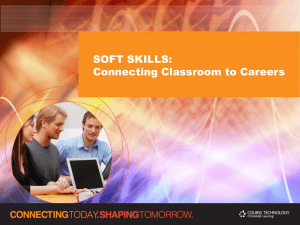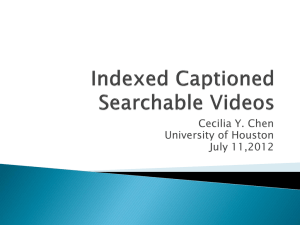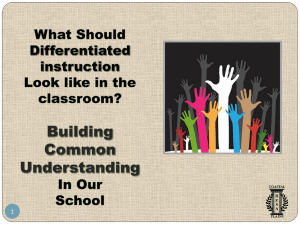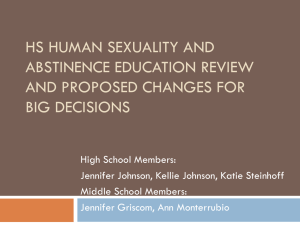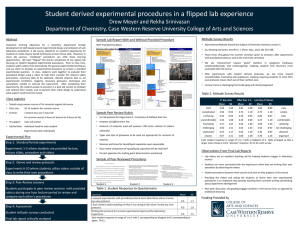362_Senior II Video Grand Rounds
advertisement
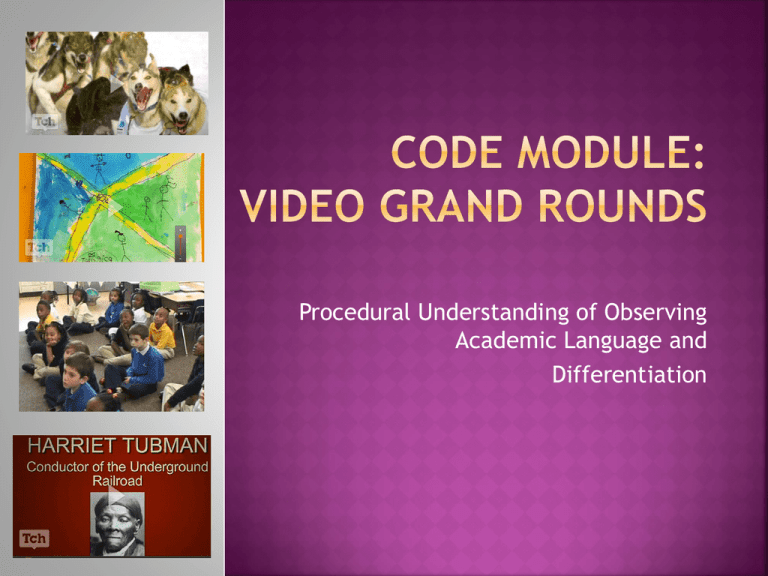
Procedural Understanding of Observing Academic Language and Differentiation Medical interns participate in Grand Rounds observations in which they view various situations in action and then debrief with their instructor. Here’s your challenge: What do you think medical interns and preservice teachers have in common? When you go into a classroom, what do you look for? Do you watch the teacher or the students? What do you think you should look for to determine if students are engaged in learning? Objectives After completing the Exploration section, you should be able to: 1. Describe the components of the observation protocol used in our Video Grand Rounds (VGR). 2. Describe the VGR process and complete the video observations utilizing the observation protocol. 3. Recognize examples of differentiation in the videos. Observation Protocol: Defined What’s This? The protocol is to be completed as you view the lesson video. It is divided into 3 sections. The first section is the Context for Observation. The second is the Learning Environment, Engagement in Learning, and Deepening Thinking section. The final section is Subject-Specific Pedagogy section. The guiding observation prompts are: 1. Did you observe the identified behaviors in each segment? (yes, no) 2. If “yes”, what evidence influenced your answer? Take a look: Observation Protocol: Learning Environment, Engagement in Learning, and Deepening Thinking Section: Organization Student Engagement Deepening Student Thinking Affective Quality of the Classroom Subject-Specific Pedagogy Section: Lesson Goals Introduction Instruction Check for Understanding Guided Practice Independent Practice Closure Scaffolding the Observation Protocol Experiences within your program have been purposely designed to scaffold the learning of key concepts identified within the Continuum of Developing Expertise (CODE) Student Learning Framework. SophomorePlanning Junior 1Planning, Instruction Junior 2Planning, Instruction, Assessment Senior 1Planning, Instruction, Assessment Senior 2 Planning, Instruction, Assessment Curriculum Diversity Differentiation (Instruction and Assessment) Academic Language Classroom Management Co-Teaching (As applicable) CODE Student Learning Framework Take a look: This is the rubric that will be used when scoring the observation protocol: Context For Observation: Defined What’s This? When observing, you need to know the demographic information of the school and classroom. This information includes how many students are in the classroom, gender, ethnicity, socio-economic status, and exceptionalities. Understanding this context for learning, provides the observer with additional information when determining the effectiveness of the observed teaching. For example, if 67% of the students in the classroom are English Language Learners and the teacher did not use any visuals when giving directions, then the observer would check no under question 2 of the Instruction segment. VGR Process: Defined What’s This? Process in which pre-service students view a series of lesson videos, complete structured observation protocols, and debrief with a faculty member following each protocol completion. Steps for completing the Video Grand Rounds: Review the video’s Context for Observation. (See following Hot Links slide.) Read the Associated Reading (See following Hot Links slide.) View the video and take notes. (See following Hot Links slide.) Complete the observation protocol on BB. Debrief your observations with your instructor and peers. Then compare your protocol to the faculty completed protocol. Think About: As you begin to view the following videos and complete an observation protocol, think about your past experiences in school. Did your teacher ever differentiate instruction, including assessments? What are some examples of ways your teacher differentiated instruction and/or assessments? Why is differentiated instruction important? Hot Links: Classroom Video Grade/ Subject Context for Observation Associated Reading Video #1: ELA Throughout the Day https://www.teachingchannel.org/videos/fifthgrade-class-culture 5th/LA Washington Elementary School Berkeley, CA 342 students Student/Teacher Ratio: 16/1 District Spending: $9,317 Academic Language http://www.academiclanguage .org/Academic_Language.html VIDEO #2 : Main Idea https://www.teachingchannel.org/videos/3rdgrade-ela-lesson 3rd/LA P.S. 110 Florence Nightingale, New York, NY 406 students Student/Teacher Ratio 13:1 $17, 108 Differentiated Instruction (pp 1-7) http://www.edugains.ca/resour cesDI/Brochures/DIBrochureO ct08.pdf Video #3: 3 R’s: Revolution, Reaction, & Reform https://www.teachingchannel.org/videos/t eaching-complex-concepts 4th/SS Think College Now School Oakland, CA 279 students Student/Teacher Ratio: 16:1 $7964 Marzano’s 6 Step Vocabulary Process http://www.ascd.org/publicatio ns/educationalleadership/sept09/vol67/num0 1/Six-Steps-to-BetterVocabulary-Instruction.aspx Video #4: Skip Counting https://www.teachingchannel.org/videos/skipcounting-with-kindergarteners K/Math Lakeridge Elementary School Seattle, WA 457 students Student/Teacher Ratio: 15:1 $8,208 Differentiated Instruction (pp 8-15) http://www.edugains.ca/resour cesDI/Brochures/DIBrochureO ct08.pdf 1. 2. 3. What are the major components of the observation protocol? Was academic language taught during the lessons in Videos #1 and #3? What did you observe that would support this? Was the content, process and/or product differentiated during the two lessons in Videos #2 and #4? What did you observe that would support this? Observation Protocol Three guiding prompts focuses observer on what is seen, not inferred. Two primary foci are Learning Environment, Engagement in Learning, and Deepening Thinking and Subject-Specific Pedagogy. Observer must include if they think the teacher was effective in what they did and why the observer thinks so. Video Summary Video #1: ELA Throughout the Day- In ELA Throughout the Day, Ms. Noonan demonstrates a variety of organizational and motivational methods for promoting ELA in general and academic language in particular. Video #2: Finding the Main Idea- In the Finding the Main Idea, Ms. Bannon begins with a whole group lesson on finding the main idea. Once she teaches the concept. She differentiates the practice by putting the students in their reading groups and assigning leveled texts at the appropriate reading level. She continues her differentiated instruction as she moves around the room talking to each group and scaffolding their learning. Video #3: 3 R’s- Mrs. Dimaggio taught her students about revolution, reaction, and reform in history. The students explored the terms in order to reach a deep understanding of the complex, abstract concepts. The students used a variety of vocabulary building strategies, cooperative pairing , and problem solving skills to determine meanings. Students were engaged in the real world problem solving. Video #4: Skip Counting with Counting Collections- In Skip Counting with Counting Collections, Ms. Latimer uses manipulatives to help develop understandings of place value. While the students are completing the same product, a counted collection, the process they use and the number in their collection (content) are differentiated by individuals and groups. Round Developers: Joy Stapleton, Kristen Cuthrell Protocol Developers: Linda Patriarca, Mike Vitale, Kristen Cuthrell, Joy Stapleton
